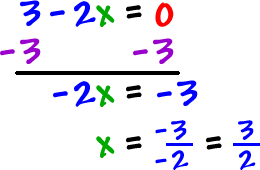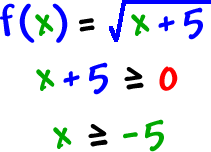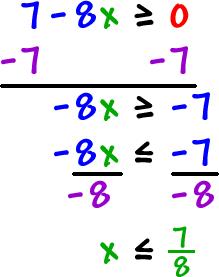OK, so suppose we don't have the graph of a function to look at like in the last section...
Can we still find the domain and range?
So, we'll just be doing domains on these -- which is really where the action is anyway.
Asking for the
domain of a function
is the same as asking
"What are all the possible
x
guys
that I can stick into this thing?"
Sometimes, what you'll really be looking for is
"Is there anything I CAN'T stick in?"
Check it out:
Do you see any
x
guys
that would cause a problem here?

So,
x
=
3
is a bad guy! Everyone else is OK, though.
The domain is all real numbers except
3
.
What would the interval notation be?
When in doubt, graph it on a number line:
 Do the interval notation in two pieces:
Do the interval notation in two pieces:
YOUR TURN:
Sometimes, you can't find the domain with a quick look.
Check it out:
Hmm... It's not so obvious!
BUT, we are still looking for the same thing:
How do we find it? Easy!
Set the denominator =
0
and solve!

TRY IT:
How about this one?
 Square roots -- what do we know about square roots?
Square roots -- what do we know about square roots?
 ... So,
... So,
16
is OK to put in.
 ... So,
... So,
0
is OK.
 ... Yuck! But,
... Yuck! But,
3.2
is OK.
 ... Nope! Can't do it!
... Nope! Can't do it!
*We only want real numbers!
No negatives are OK!
 The
The
inside
of aradical
cannot be negative if we wantreal answers
only (no
i
guys). So, the
inside
of aradical
has to be0 or a positive number
.
Now, let's find the domain of

TRY IT:
Here's a messier one:

Can we still find the domain and range?
Domains : |
Yes (as long as the algebra doesn't get too hairy... and it won't for us.) |
Ranges : |
Not really (you usually need the picture -- unless it's something really basic.) |
So, we'll just be doing domains on these -- which is really where the action is anyway.
Asking for the
domain of a function
is the same as asking
"What are all the possible
x
guys
that I can stick into this thing?"
Sometimes, what you'll really be looking for is
"Is there anything I CAN'T stick in?"
Check it out:
| Let's find the domain of |  |
x
guys
that would cause a problem here?
| What about |  |
? |

So,
x
=
3
is a bad guy! Everyone else is OK, though.
The domain is all real numbers except
3
.
What would the interval notation be?
When in doubt, graph it on a number line:

| domain |  |
YOUR TURN:
| Find the domain of |  |
Sometimes, you can't find the domain with a quick look.
Check it out:
| Let's find the domain of |
 |
BUT, we are still looking for the same thing:
 |
The bad x that makes the denominator 0 ! |
Set the denominator =
0
and solve!

| The domain is |
 |
TRY IT:
| Find the domain of |  |
*show work!! |
How about this one?

 ... So,
... So,16
is OK to put in.
 ... So,
... So,0
is OK.
 ... Yuck! But,
... Yuck! But,3.2
is OK.
 ... Nope! Can't do it!
... Nope! Can't do it!*We only want real numbers!
No negatives are OK!

inside
of aradical
cannot be negative if we wantreal answers
only (no
i
guys). So, the
inside
of aradical
has to be0 or a positive number
.
| Set |  |
and solve it! |

| So, the domain of |  |
is |  |
. |
TRY IT:
| Find the domain of |  |
. *Show work!! |
Here's a messier one:
| Let's find the domain of |  |
Set |
 |
and solve! |

| The domain is | ![( -infinity , 7 / 8 ]](https://www.coolmath.com/sites/default/files/images/06-functions-25.gif) |
. |
from Fruitty Blog https://ift.tt/2ZQbMTF
via IFTTT

No comments:
Post a Comment